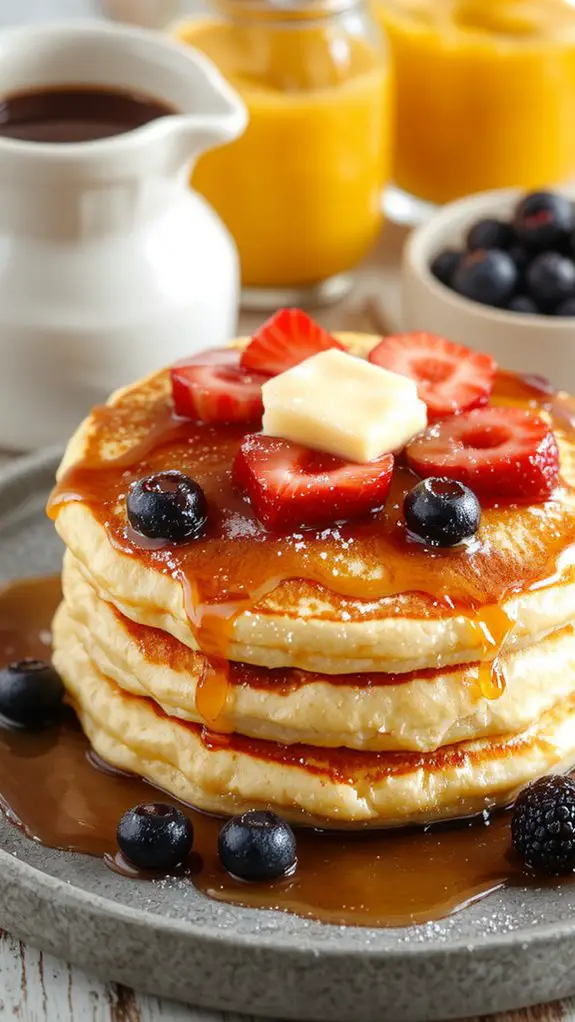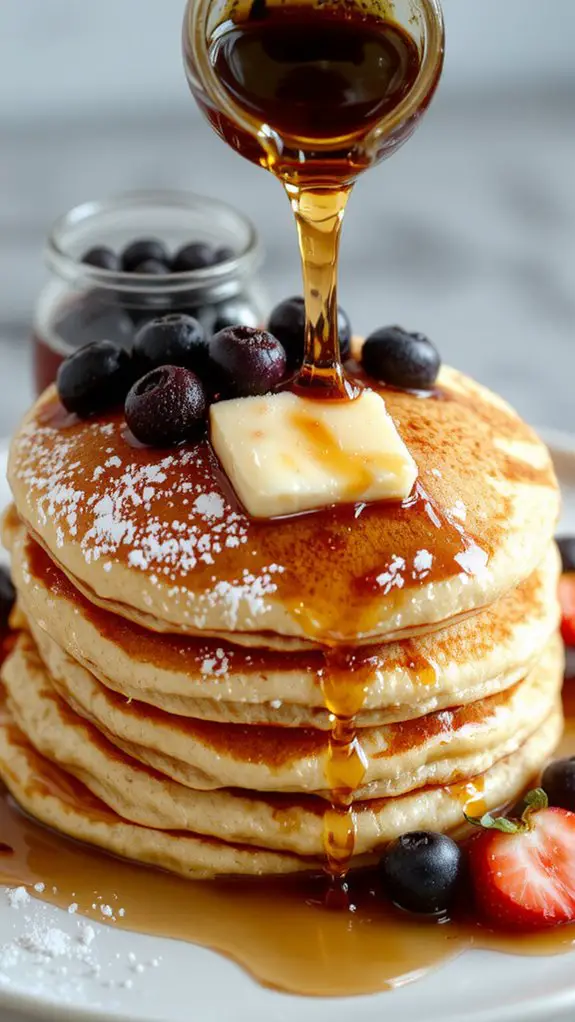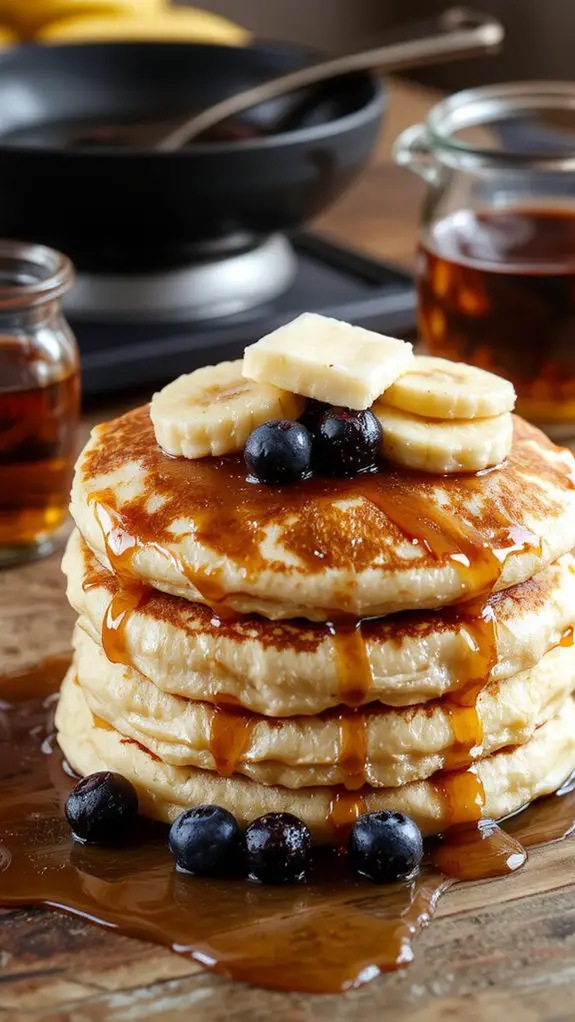Recipe
There’s something magical about homemade pancakes—fluffy, golden, and just begging to be drenched in syrup. This recipe? It’s the one I swear by, the kind that turns Sunday mornings into something special.
What makes it unbeatable? A touch of vanilla and a pinch of cinnamon for warmth, plus a foolproof method that guarantees stacks so light, they practically float off the plate.
No fancy ingredients, no complicated steps—just pure, buttery comfort with crispy edges and a melt-in-your-mouth center. Whether you’re a pancake pro or a first-time flipper, this recipe is your ticket to breakfast bliss.
Trust me, once you try these, the boxed mix is going straight in the trash.
Ingredients
For the fluffiest, most flavorful pancakes, using the right ingredients matters more than you might think. A well-balanced mix guarantees a tender crumb, golden exterior, and just the right amount of sweetness. Don’t stress if you’re missing something—there are plenty of smart swaps to keep your pancake game strong.
- All-purpose flour: The backbone of the batter. For lighter pancakes, swap in cake flour.
- Baking powder: Non-negotiable for that perfect rise—make sure it’s fresh for maximum fluff.
- Granulated sugar: Just a touch adds sweetness and helps with browning. Swap with honey or maple syrup for a deeper flavor.
- Salt: Balances the sweetness and enhances all the flavors—don’t skip it.
- Eggs: Adds structure and richness. For a vegan option, use a flax egg (1 tbsp ground flaxseed + 3 tbsp water).
- Whole milk: Creates a creamy batter. Substitute with buttermilk for extra tang and tenderness, or use plant-based milk like almond or oat.
- Unsalted butter: Melted butter adds richness and helps prevent sticking. Swap with coconut oil or a neutral oil if needed.
- Vanilla extract: A must for depth of flavor. Almond extract works as a fun alternative.
- Fresh berries or chocolate chips (optional): Fold them in for a burst of flavor and texture.
- Maple syrup or whipped cream (optional): Serve on top for that classic pancake experience.
Pro tip: Let the batter rest for 5–10 minutes before cooking—it helps the flour hydrate and makes for a more tender pancake.
And always cook on a preheated, lightly greased griddle or pan for even browning.
How to Make the Best Fluffy Buttermilk Pancakes

– Lightly grease the skillet with butter or oil, then pour ¼-cup portions of batter onto the surface. A light coating prevents sticking, and consistent portions guarantee even cooking.
– Cook until bubbles form on the surface and the edges look set, about 2-3 minutes. This is your cue that the bottom is golden and it’s time to flip.
– Flip the pancakes gently and cook for another 1-2 minutes until golden brown on both sides. Avoid pressing them down with the spatula—this can deflate the fluffiness.
– Transfer cooked pancakes to a warm plate and cover loosely with foil to retain heat. Keeping them warm guarantees they’re ready to serve together.
– Repeat with the remaining batter, greasing the skillet as needed. Adjust the heat slightly if pancakes are browning too quickly.
– Serve immediately with your favorite toppings, like syrup, butter, or fresh fruit. Freshly cooked pancakes are at their best when enjoyed right away!
Pro Tip: No buttermilk? Mix 1 cup milk with 1 tablespoon lemon juice or vinegar, let it sit for 10 minutes, and use as a substitute.
Watch-Out Warning: Overmixing the batter is the #1 mistake that leads to dense pancakes—gentle stirring is key!
Nutrition
Pancakes are a quick and easy breakfast option. Here’s the nutritional breakdown for a serving of homemade pancakes.
| Nutrition | Amount |
|---|---|
| Calories | 227 |
| Total Fat | 9.6g |
| Saturated Fat | 2.3g |
| Cholesterol | 26mg |
| Sodium | 449mg |
| Total Carbohydrate | 29.5g |
| Dietary Fiber | 0.9g |
| Sugars | 5.4g |
| Protein | 6.3g |
Chef Tips
Knowing the nutritional value is helpful, but I’ve found that mastering a few techniques can make your pancakes even better.
Use room-temperature ingredients to guarantee even mixing. Don’t overmix the batter—it’s okay if it’s slightly lumpy.
Preheat your pan and test with a drop of water; it should sizzle. Flip pancakes when bubbles form and edges look set.
Keep them warm in a low oven.
Frequently Asked Questions
Can I Freeze Leftover Pancake Batter?
Yes, I can freeze leftover pancake batter! I pour it into a freezer-safe container or bag, leaving space for expansion. I thaw it overnight in the fridge before using it, stirring it well to recombine.
What’s the Best Substitute for Buttermilk?
I’d mix 1 cup of milk with 1 tablespoon of lemon juice or white vinegar as my go-to buttermilk substitute. I let it sit for 5-10 minutes; it curdles and mimics buttermilk’s tangy flavor perfectly.
How Do I Prevent Pancakes From Sticking to the Pan?
I always make sure my pan’s hot and lightly greased with butter or oil before pouring the batter. If I’m using a nonstick pan, I’ll still add a thin layer of grease to be safe.
Can I Make Pancakes Gluten-Free?
Yes, I can make pancakes gluten-free by swapping regular flour for gluten-free alternatives like almond, oat, or a gluten-free flour blend. I’ll also confirm my baking powder and other ingredients are gluten-free to avoid cross-contamination.
Why Are My Pancakes Turning Out Dense?
I think your pancakes are dense because you’re overmixing the batter—it toughens the gluten. I also check if my baking powder’s fresh or if I’m using too much flour. A lighter hand makes fluffier pancakes.










